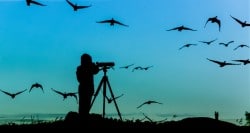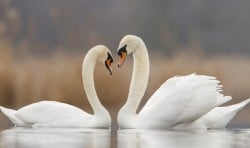In Defense of Bird Watching: Ornithology in Niagara Falls
January 23, 2015 10:03 am Unfortunately, it seems that bird watching is becoming a dying art. Fewer and fewer people stroll in the wilderness searching for a burst of colorful feathers or particularly sweet song marking the nearby existence of a particular bird species. Instead, the trails are filled with fitness enthusiasts using nature for a healthy caloric burn or office junkies enjoying the simple pleasures of fresh air and sunshine. These experiences aren’t to be deplored, but they can easily be joined with the myriad other pleasures that include bird watching. For example, bird watching:
Unfortunately, it seems that bird watching is becoming a dying art. Fewer and fewer people stroll in the wilderness searching for a burst of colorful feathers or particularly sweet song marking the nearby existence of a particular bird species. Instead, the trails are filled with fitness enthusiasts using nature for a healthy caloric burn or office junkies enjoying the simple pleasures of fresh air and sunshine. These experiences aren’t to be deplored, but they can easily be joined with the myriad other pleasures that include bird watching. For example, bird watching:
- Brings the family closer together with a community activity perfect for any age.
- Fosters an appreciation for animals and nature.
- Educates about different indigenous and invasive species in a particular area.
- Keeps stress levels down by allowing the mind to focus on a relaxing and low-pressure challenge.
- Improves mental faculties by engaging recognition and memory.
Niagara Falls is a beautiful natural environment, and there are plenty of opportunities for novice naturalists to hone beginning bird watching skills. On your next trip to Niagara Falls, keep your eyes peeled for these feathered friends, and you may feel your mind grow stronger as you reconnect with nature in newer and deeper ways.
1. Red-Headed Woodpecker
Vibrant and fun to watch, red-headed woodpeckers are one of the most exciting flying finds of the Niagara region. As the name suggests, these birds have bright red heads, and their bodies are seemingly checkerboard black and white. Red-headed woodpeckers are commonly seen looking for snacks underneath the bark of pine trees, but unlike other woodpeckers, they are also adept at catching insects on the fly, meaning watchers might be treated to an astounding aerial show. Plus, the promise of hilarious antics like those of famous animated character Woody Woodpecker might get kids (of all ages) invested in the search.
2. Great Blue Heron
You’ll most often catch site of this bird standing stately near a body of water. Great blue herons are tall, majestic birds with curled, s-shaped necks and blue-gray feathers, and like other herons, they prefer wading in shallow water to stalk their meal of choice: fish. Though their wings move slowly in flight, don’t mistake these birds for clumsy or sluggish — when on the hunt, their dagger-shaped beaks can move lightning-fast to catch quick-swimming prey.
3. Mute Swan
 Though the swan isn’t a native of the region, it has taken to Niagara like a fish to water. With bright, white plumage and a gracefully curved neck, the swan has earned its place as one of the most elegant birds on Earth. Despite its common name, swans do make noise; keep your ears open for a trilling honk when you’re near ponds and lakes, and you might be able to spot a wild swan. However, be careful not to approach any swans, as these birds are highly territorial and aggressive, and their wings and beaks are surprisingly strong.
Though the swan isn’t a native of the region, it has taken to Niagara like a fish to water. With bright, white plumage and a gracefully curved neck, the swan has earned its place as one of the most elegant birds on Earth. Despite its common name, swans do make noise; keep your ears open for a trilling honk when you’re near ponds and lakes, and you might be able to spot a wild swan. However, be careful not to approach any swans, as these birds are highly territorial and aggressive, and their wings and beaks are surprisingly strong.
4. Wood Duck
One of the most famous birds in the world, the duck may not be rare or novel, but it continues to be one of the best birding experiences around. In designated places, you may even be able to purchase feed (or bring your own) so you can get up close and personal with our fine-feathered friends.
Categories: Falls Avenue Resort
